Search the Special Collections and Archives Portal
Search Results
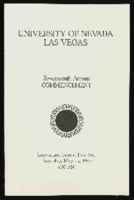
University of Nevada, Las Vegas (UNLV) 17th commencement program
Date
Archival Collection
Description
Commencement program from University of Nevada, Las Vegas Commencement Programs and Graduation Lists (UA-00115).
Text
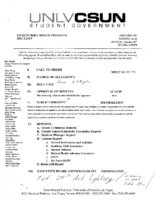
Meeting minutes for Consolidated Student Senate, University of Nevada, Las Vegas, January 28, 2008
Date
Archival Collection
Description
Text
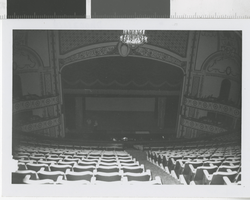
Photograph of the interior of the Shubert Theatre, Cincinnati (Ohio), 1970
Date
Archival Collection
Description
Image
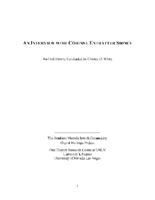
Transcript of interview with Corinne Entratter Sidney by Claytee White, June 5, 2007
Date
Archival Collection
Description
Interview with Corinne Entratter Sidney by Claytee White on June 5, 2007. In this interview, Sidney talks about growing up with privilege in California, where her father served as the attorney general. She attended school at UCLA and took acting classes and signed with United Artists. She met Jack Entratter in Los Angeles and moved to Las Vegas and worked as a Copa Girl. She discusses Jack Entratter's generosity and influence in town, and his style, and their lifestyle together. She mentions the likes of Frank Sinatra, Lena Horne and Sammy Davis, Jr. and her extravagant life living at the Sands. After Jack's death in 1971, she moved back to Los Angeles, returned to acting, and wrote a newspaper column. On a visit to Las Vegas with George Sidney after Sidney's wife Jane died, Corinne and George began dating and were married shortly after. They moved back to Las Vegas together for a slower pace. She describes her love of Las Vegas and its continued growth.
Corinne Sidney's life story makes for fascinating reading. She was born in 1937, the daughter of Alice Polk, former Ziegfeld showgirl, and Carl Kegley, an attorney. She attended U. of C. Berkeley, transferred to UCLA, and was spotted by a talent scout who convinced her to enter a Miss USA contest. Corinne's runner-up status in the Miss USA contest led to job offers in acting, so she decided to study acting. This, along with her childhood lessons in ballet, piano, singing, tap dance and horseback riding, led to a contract with United Artists, freelance work, television parts, and plays. Around the age of 18, Corinne met Jack Entratter. Their relationship brought her to Las Vegas, where she worked as a showgirl at the Sands for a few months, and where she married Jack a few years later. They lived a fabulous lifestyle which included travel, beautiful homes, and friendships with noted celebrities. Corinne went back to acting in Los Angeles after Jack passed away, but then segued into writing a gossip column and hosting a television show. She reconnected with an old friend (George Sidney) by writing the obituary for his wife, and within a few months they were married. The Sidney's moved back to Las Vegas, where Corinne still makes her home today.
Text

Interview with Richard Van Nutley, November 8, 2004
Date
Archival Collection
Description
Text
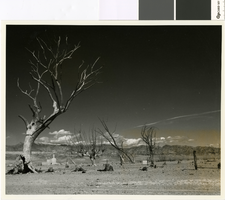
Photograph looking west through the remains of Saint Thomas, March 25, 1964
Date
Archival Collection
Description
Looking west through the remains of Saint Thomas from near the remains of Jacob Baver's blacksmith shop.
Transcribed Notes: Bureau of Reclamation typed notes appended to back of photo: Townsite of St. Thomas, Nevada--Moapa Valley Project--Nevada A view of a portion of the townsite of St. Thomas, Nevada, settled by the Mormons in 1865, during a period of low water elevation in Lake Mead above Hoover Dam. The town was first covered by Lake Mead in June 1938.
Image
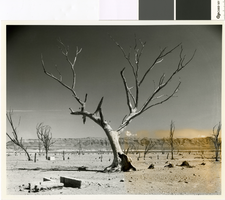
Photograph looking southeast through the remains of Saint Thomas, March 25, 1964
Date
Archival Collection
Description
Looking southeast through the remains of Saint Thomas with Lake Mead in the background.
Transcribed Notes: Bureau of Reclamation typed notes appended to back of photo: Townsite of St. Thomas, Nevada--Moapa Valley Project--Nevada A view of a portion of the townsite of St. Thomas, Nevada, settled by the Mormons in 1865, during a period of low water elevation in Lake Mead, above Hoover Dam. The town was first covered by Lake Mead in June 1938.
Image
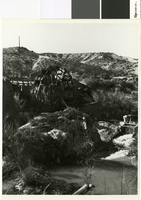
Photograph of waterwheel on the Muddy River near Logandale, Nevada, January 21, 1947
Date
Archival Collection
Description
38 foot waterwheel on the Muddy River near Logandale, Nevada.
Transcribed Notes: Bureau of Reclamation typed notes appended to back of photo: Boulder Canyon Project, Nevada Region 3 A 38-foot water wheel lifts water 30 feet from the Muddy River to irrigate a farm near Glendale, Nevada.
Image
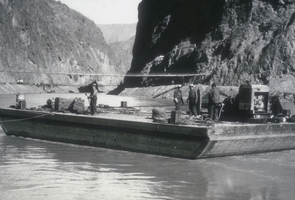
Slide of the barged used in construction phase of Hoover Dam, Colorado River, January 10, 1932
Date
Archival Collection
Description
Image
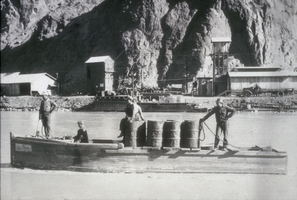
Slide of boats used in construction phase of Hoover Dam, January 10, 1932
Date
Archival Collection
Description
Image
